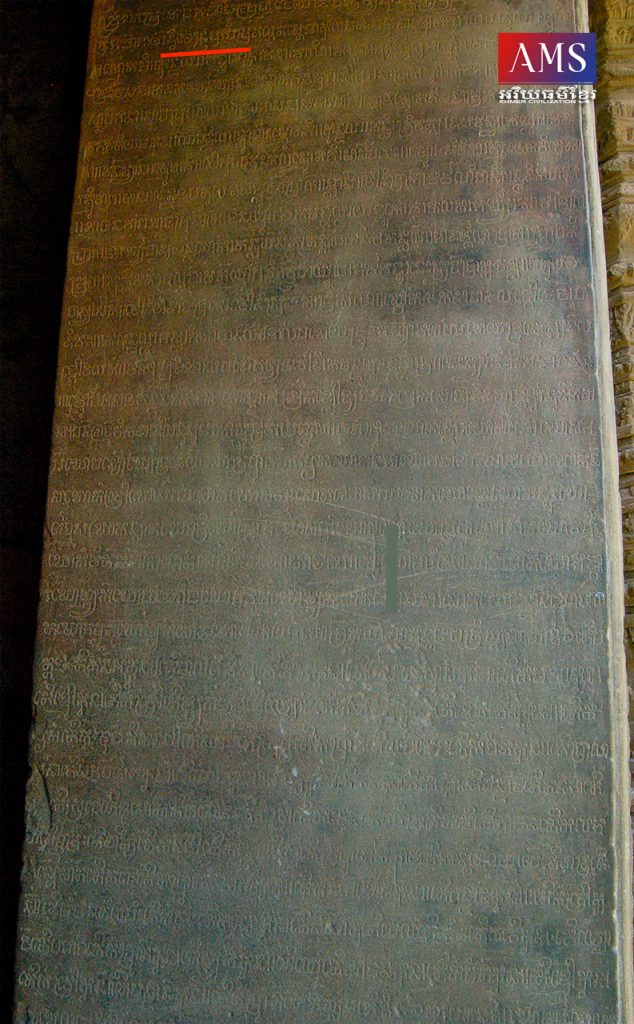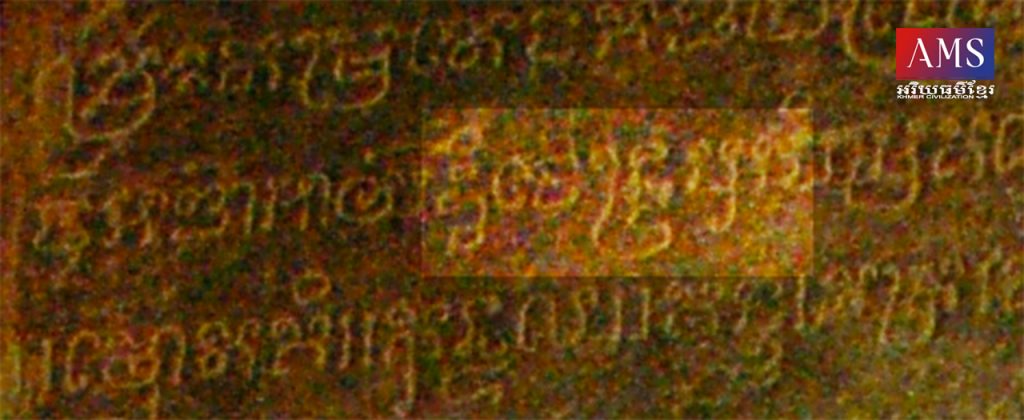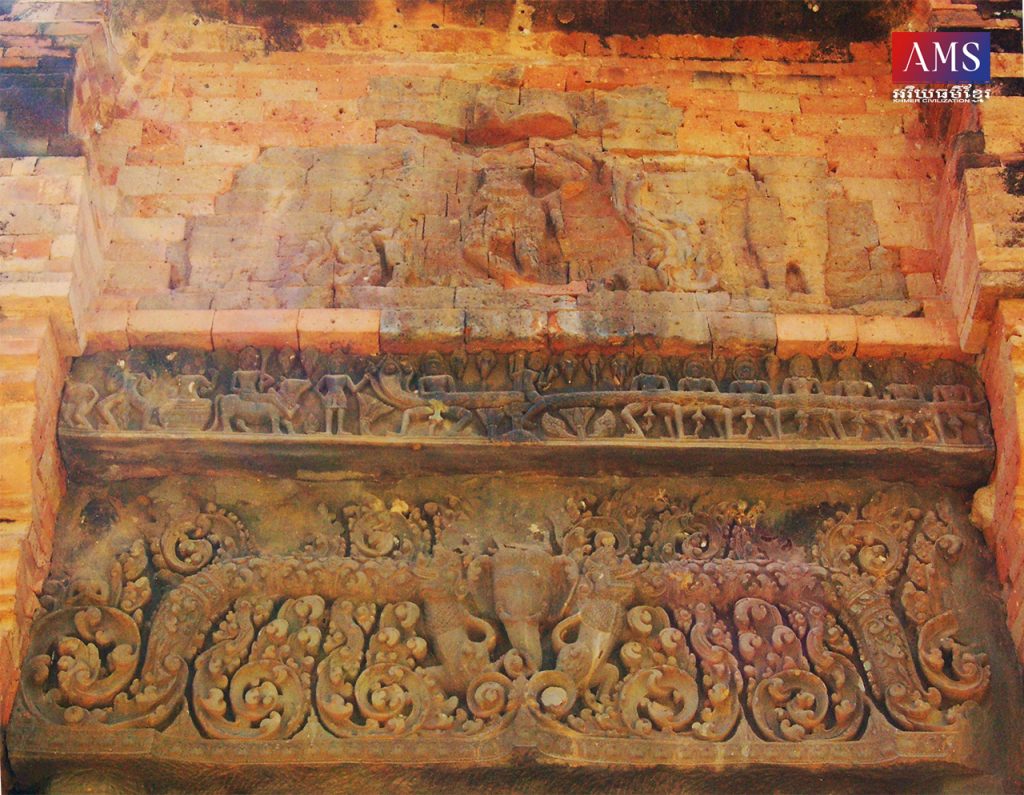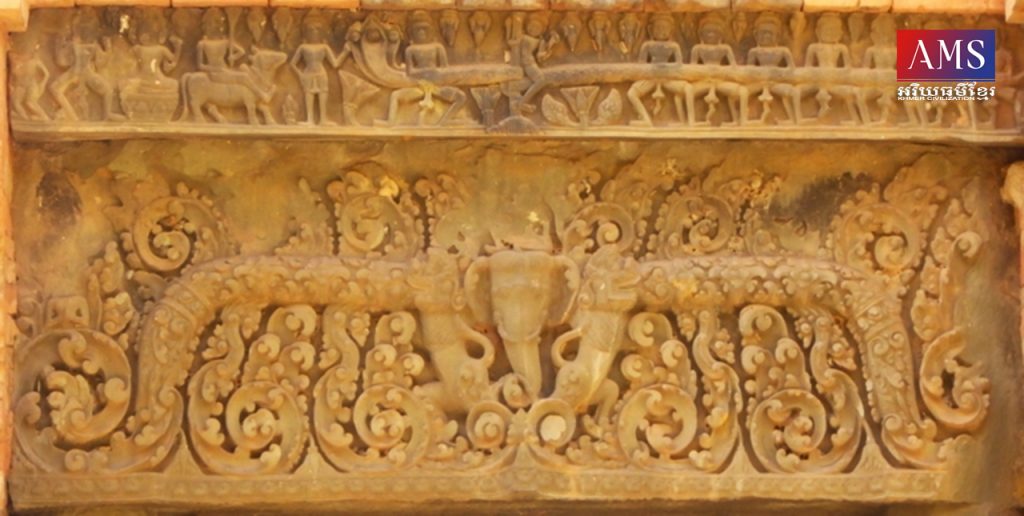Wat Preah Enkosey Monastery: Wat Preah Enkosey Monastery or the Siem Reap people commonly call “Wat Leu” which is located in Traing village, Siem Reap city, opposite the Angkor Conservation, east the Siem Reap River. There is a brick temple inside the pagoda compound, according to the researchers concluded that the temple has three towers but in fact, we see today there are only two towers. In the inscription of the temple inscribed the name “Twichentrapura” (Twichentra City), which could mean a city with two towers? Or could it mean another meaning?
According to inscriptions K.262, the temple was built in the 10th century. The inscription mentions the construction of the temple with the name “Twichentrapura”, the name of the ancient site, which is now located at the site of the Wat Preah Enkosey Monastery. The name “Twichentrapura” was built in 968 AD, meaning the beginning of the reign of King Jayavarman V (reigning from 968 ~ 2001 AD). Regarding the date of 968 also contained on inscriptions of another temple, originally named “Madhuvana” in Khmer, “Prey Khmum”, built in 968 by the Brahma named Divākarabhaṭṭa. Brahma married Indralaksmey, the daughter of King Rajendravarman (reigned from 944 to 968).
In the southern tower, there was remains a lintel with a clear view of some of the gods and mythology but a lintel has damaged a middle part which remained a elephant statue and various deities but what is remarkable is the story of the Churning of the Sea of the Milk, which was very popular in the Angkorian. The name is now known as “Preah Enkosey” is the name of Indra in Theravada Buddhism. “Kosi” is synonymous with the Sanskrit word “Kośavant”, another name of Indra, which means “fate or fortune”. The name “Kosi” is found in many texts in Post-Angkorian, especially in the 17th century Angkor Wat poetry. Therefore, the name “Preah Enkosey” as it is called today is important because it allows us to know the relationship of this pagoda to the Post-Angkorian (14th to 19th centuries).
វត្តព្រះឥន្រ្ទកោសីយ៍ ឬជាទូទៅអ្នកសៀមរាបហៅ “វត្តលើ” ស្តិតនៅភូមិទ្រាំង ក្រុង សៀមរាប ទល់មុខអភិរក្សអង្គរ ខាងកើតស្ទឹងសៀមរាប។ ដែលអ្នកសៀមរាបហៅ “វត្តលើ” ពីព្រោះកាលជំនាន់ដើម នៅក្នុងខេត្តសៀមរាបវត្តនេះនៅផ្នែកខាងលើគេ បើគិតតាមខ្សែទឹកហូរនៃស្ទឹងសៀមរាបដែលហូរចុះពីភ្នំគូលែនហូរទៅទន្លេសាប។ ការហៅឈ្មោះទីតាំង ដោយគិតទៅតាមចរន្តទឹកស្ទឹងហូររបៀបនេះជារឿងធម្មតា។ ឧទាហរណ៍នៅខេត្តសៀមរាប មានឈ្មោះផ្សារលើ ផ្សារក្រោម មានឈ្មោះវត្តពោធិលើ វត្តពោធិក្រោម។ល។ ខេត្តដទៃទៀតដែលមានចរន្តទឹកស្ទឹងបែបនេះ ពោលគឺមានឈ្មោះដូចគ្នាដែរ។
នៅក្នុងបរិវេណវត្តនេះមានប្រាសាទសាងអំពីឥដ្ឋ អ្នកស្រាវជ្រាវបារាំងបានឱ្យសន្និដ្ឋាន ថាប្រាសាទនេះមានតួប៉មបី ប៉ុន្តែជាក់ស្ដែងយើងឃើញសព្វថ្ងៃមានតួប៉មតែពីរប៉ុណ្ណោះ។ នៅក្នុងសិលាចារឹកនៃប្រាសាទនេះផ្ទាល់មានចារឈ្មោះថា “ទ្វិជេន្ទ្របុរ” (ក្រុងទ្វិជេន្ទ្រ) ថ្វីត្បិត ថាពិបាកប្រែន័យ “ទ្វិជេន្ទ្រ” ឱ្យត្រូវពិតប្រាកដក្ដីអ្នកស្រាវជ្រាវខ្លះសន្និដ្នានថាអាចមានន័យ “ក្រុងដែលមានប្រាសាទពីរ?” ដែលសមស្របទៅនឹងបរិបទ នៃប្រាសាទនេះផ្ទាល់ដែលមានតួពីរ។ ឬឈ្មោះនេះអាចមានន័យផ្សេងទៀត?។
យោងតាមសិលាចារឹក ប្រាសាទនេះសាងនៅក្នុងសតវត្សទី១០។ នៅស៊ុមទ្វារនៃប្រាសាទនេះមានសិលាចារឹកពីរផ្ទាំងដែលមានចុះបញ្ជីលេខ ជាភាសាខ្មែរ និង K.262 ជាភាសាសំស្ក្រឹត និងខ្មែរ។ សិលាចារឹកនិយាយអំពីការស្ថាបនាប្រាសាទ ដោយមានសរសេរឈ្មោះ “ទ្វិជេន្ទ្របុរ” ដែលជាឈ្មោះទីតាំងបុរាណ ពោលគឺសព្វថ្ងៃស្ថិតនៅចំទីតាំងនៃវត្តព្រះឥន្រ្ទកោសីយ៍នេះ។ លោក សឺដែស (Goerge Cœdès) សន្និដ្ឋានថាសិលាចារឹក K.262 ដែលចារទាក់ទងនឹងឈ្មោះ “ទ្វិជេន្ទ្របុរ” សាងនៅគ.ស.៩៦៨ ពោលគឹចូលដល់ដើមរាជ្យរបស់ព្រះបាទជ័យវរ្ម័នទី៥ (គ្រងរាជ្យពី គ.ស.៩៦៨~គ.ស.១០០២)។ ទាក់ទងនឹងកាលបរិច្ឆេទគ.ស.៩៦៨ ដែលចារនៅលើសិលាចារឹកនៃប្រាសាទនេះ ក៏មានចារនៅសិលាចារឹកនៃប្រាសាទមួយទៀតដែលមានឈ្មោះដើម “Madhuvana” បើជាភាសាខ្មែរថា “ព្រៃឃ្មុំ” សាងនៅឆ្នាំ៩៦៨ ដោយព្រាហ្មឈ្មោះ ទិវាករភដ្ដ (Divākarabhaṭṭa)។ ព្រាហ្មនោះបានរៀបអភិសេកជាមួយព្រះនាង ឥន្ទ្រលក្ស្មី ជាបុត្រីរបស់ព្រះបាទរាជេន្ទ្រវរ្ម័ន (គ្រងរាជ្យពីគ.ស.៩៤៤ ដល់គ.ស.៩៦៨)។
នៅតួប៉មខាងត្បូងមាននៅសល់ផ្ដែរច្បាស់ល្អអាចមើលដឹងអំពីទេព និងទេពកថាខ្លះ។ នៅផ្នែកខាងក្រោមនៃផ្ដែរ ថ្វីត្បិតនៅផ្នែកកណ្ដាលជ្រុះបាត់ចម្លាក់ទេពក្ដី ប៉ុន្តែនៅ មានសល់រូបដំរីដែលអាចឱ្យយើងដឹងថាទេពនេះជាព្រះឥន្ទ្រ។ នៅផ្នែកខាងលើផ្ដៃរមាន ចម្លាក់ទេពផ្សេងៗ ប៉ុន្តែអ្វីដែលគួរឱ្យកត់សម្គាល់នោះ គឺមានបង្ហាញអំពីទេពកថាក្នុង រឿងកូរសមុទ្រទឹកដោះ ដែលជារឿងមានការពេញនិយមណាស់នៅសម័យអង្គរ។ ចំពោះឈ្មោះដែលគេហៅសព្វថ្ងៃថា “ព្រះឥន្រ្ទកោសីយ៍” គឺជាឈ្មោះរបស់ព្រះឥន្ទ្រនៅក្នុងព្រះពុទ្ធសាសនាថេរវាទ។ “កោសីយ៍” មានន័យដូចនឹងពាក្យសំស្ក្រឹត “កោសវន្ត Kośavant” ជាឈ្មោះរបស់ព្រះឥន្ទ្រមួយទៀត ហើយដែលមានន័យថា “ជោគវាសនា ឬសំណាង”។ ឈ្មោះ “កោសីយ៍” នេះឃើញមានច្រើននៅក្នុងអត្ថបទសម័យកណ្ដាល ជាពិសេសនៅក្នុងកំណាព្យល្បើកអង្គរវត្តដែលគេតែងនៅសតវត្សទី១៧។ ដូច្នេះឈ្មោះ “ព្រះឥន្រ្ទកោសីយ៍” ដែលហៅសព្វថ្ងៃនេះគឺសំខាន់ ព្រោះអាចឱ្យយើងដឹងអំពីទំនាក់ទំនងរបស់វត្តនេះទៅនឹងសម័យកណ្ដាល (ស.វទី១៤ ដល់ស.វទី១៩)។
អត្ថបទដើម៖ លោក ញឹម សុធាវិន្ទ










